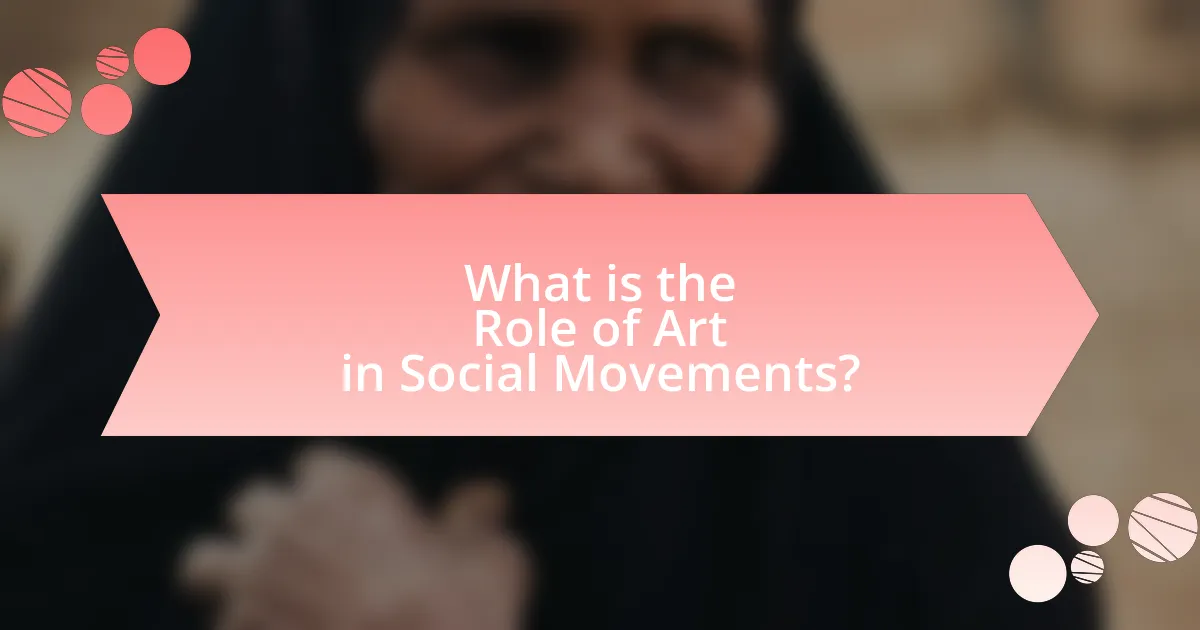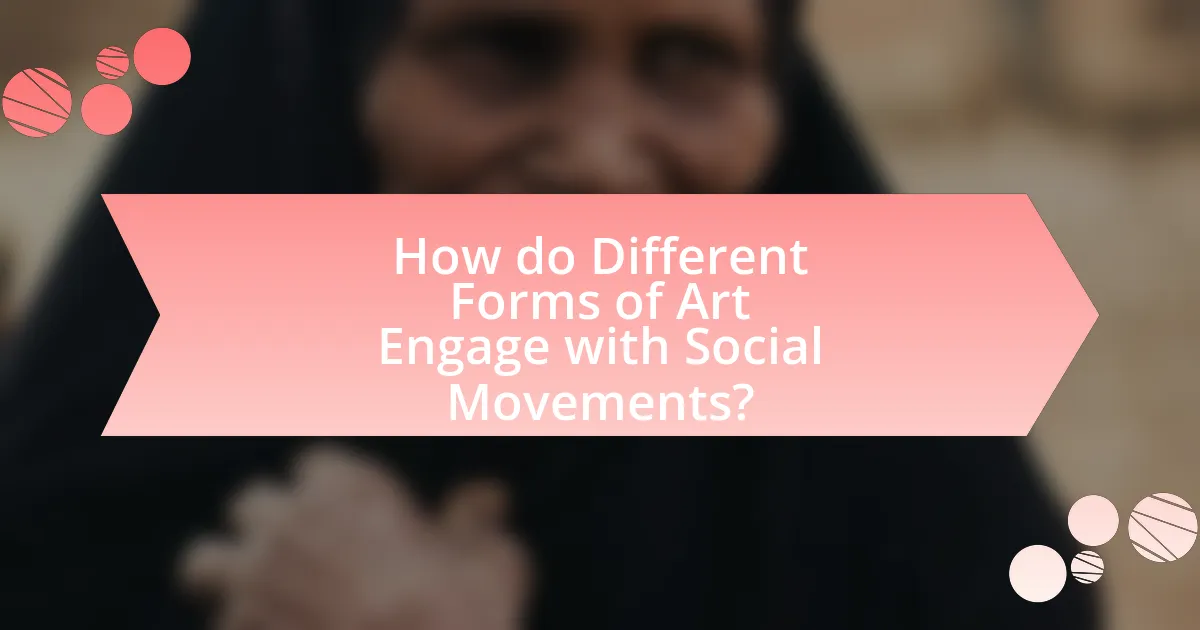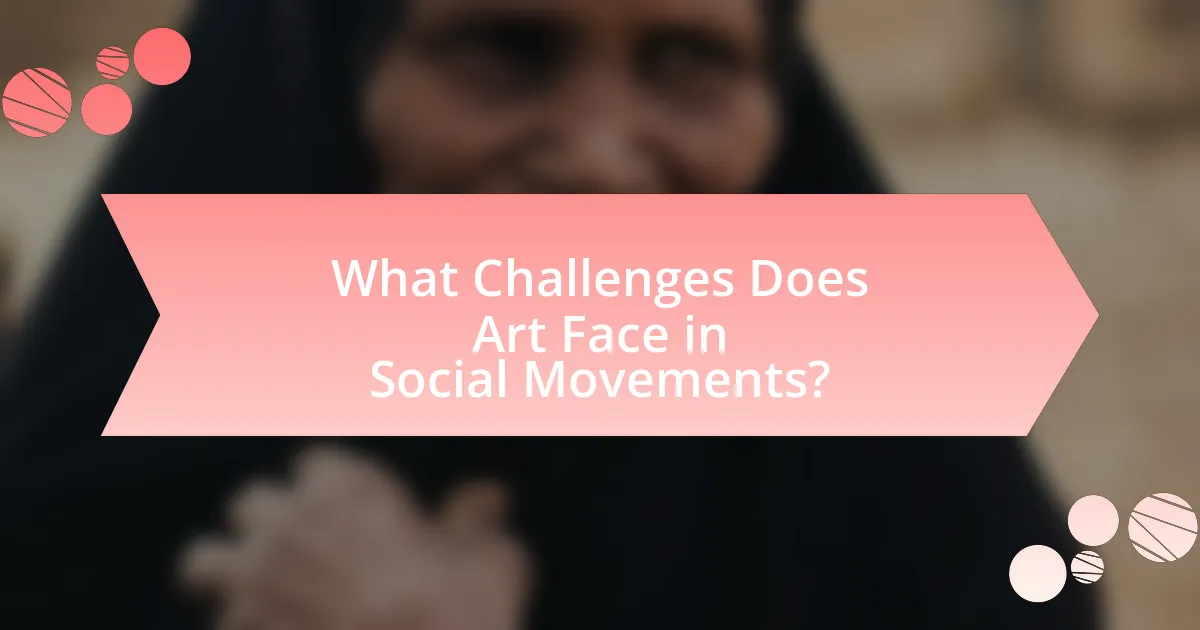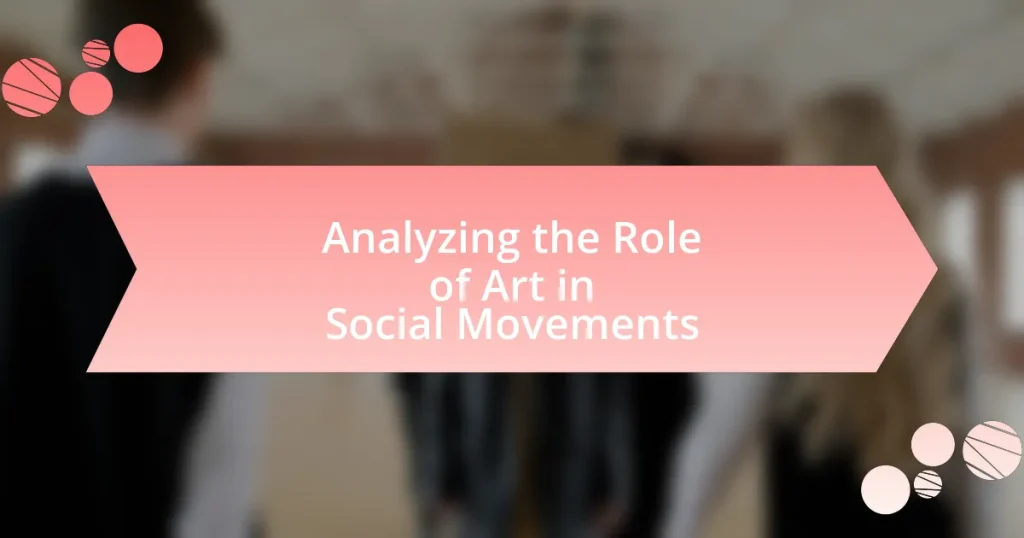The article analyzes the role of art in social movements, highlighting its significance as a tool for communication, expression, and mobilization. It discusses historical examples, such as protest songs during the Civil Rights Movement and visual art from the Mexican muralist movement, illustrating how art has influenced public perception and inspired collective action. The article also examines the emotional and psychological impacts of art on audiences, the various forms of art used in activism, and the challenges artists face, including censorship and misinterpretation. Additionally, it outlines best practices for integrating art into social movements, emphasizing collaboration between artists and activists to enhance the effectiveness of artistic expression in advocating for social change.

What is the Role of Art in Social Movements?
Art plays a crucial role in social movements by serving as a powerful tool for communication, expression, and mobilization. It conveys messages that resonate emotionally with audiences, often transcending language barriers and fostering a sense of community among activists. Historical examples include the use of protest songs during the Civil Rights Movement, which galvanized support and articulated the struggles faced by marginalized groups. Additionally, visual art, such as murals and posters, has been instrumental in raising awareness and inspiring action, as seen in the works of artists like Diego Rivera, who depicted social injustices in Mexico. These artistic expressions not only document social issues but also inspire collective action, making art an essential component of social movements.
How has art historically influenced social movements?
Art has historically influenced social movements by serving as a powerful tool for expression, mobilization, and awareness. Throughout history, art has captured the sentiments of marginalized groups, providing a voice to their struggles and aspirations. For instance, the Harlem Renaissance in the 1920s utilized literature, music, and visual arts to challenge racial discrimination and promote African American culture, significantly impacting the Civil Rights Movement that followed. Similarly, the anti-war movement during the Vietnam War era saw the rise of protest songs and visual art that galvanized public opinion against the conflict, exemplified by works like Picasso’s “Guernica,” which condemned the horrors of war. These examples illustrate how art not only reflects societal issues but also inspires collective action and fosters a sense of community among activists.
What are some key examples of art in historical social movements?
Key examples of art in historical social movements include the use of protest songs during the Civil Rights Movement, such as “We Shall Overcome,” which became an anthem for equality and justice. Additionally, the Mexican muralist movement, particularly the works of Diego Rivera, visually represented social and political themes, advocating for workers’ rights and social change. The feminist art movement of the 1970s, exemplified by artists like Judy Chicago, challenged gender norms and highlighted women’s issues through installations like “The Dinner Party.” These examples illustrate how art has served as a powerful tool for expression and mobilization in various social movements throughout history.
How did these examples shape public perception and action?
Art in social movements has significantly shaped public perception and action by serving as a powerful medium for communication and advocacy. For instance, the use of visual art, such as murals and installations, has raised awareness about social issues, influencing public sentiment and mobilizing communities. Historical examples include the murals of the Chicano Movement, which highlighted cultural identity and social justice, leading to increased activism and community organization. Additionally, performance art during the AIDS crisis, such as the work of ACT UP, effectively conveyed urgency and humanized the epidemic, prompting public response and policy changes. These artistic expressions not only captured attention but also fostered dialogue, ultimately driving collective action and societal change.
Why is art considered a powerful tool for social change?
Art is considered a powerful tool for social change because it effectively communicates complex ideas and emotions, fostering empathy and awareness among diverse audiences. Historical examples, such as the use of protest songs during the Civil Rights Movement, illustrate how music galvanized public support and mobilized action against racial injustice. Additionally, visual art, like the murals of Diego Rivera, has served to critique social inequalities and inspire collective action. Research shows that art can influence public opinion and policy, as seen in campaigns like “Art for Change,” which leverage creative expression to address social issues.
What emotional and psychological impacts does art have on audiences?
Art profoundly influences audiences by evoking a range of emotions and fostering psychological responses. It can elicit feelings of joy, sadness, anger, or nostalgia, often leading to a deeper understanding of personal and collective experiences. For instance, studies have shown that engaging with art can enhance emotional intelligence and empathy, as individuals connect with the narratives and emotions portrayed. Research published in the journal “Psychology of Aesthetics, Creativity, and the Arts” indicates that exposure to art can reduce stress and anxiety, promoting mental well-being. Furthermore, art serves as a catalyst for social change, inspiring audiences to reflect on societal issues and motivating them to participate in social movements. This connection between art and emotional engagement underscores its significant role in shaping public consciousness and individual psychological states.
How does art facilitate communication and solidarity among activists?
Art facilitates communication and solidarity among activists by serving as a universal language that transcends barriers and conveys complex messages effectively. Through visual imagery, performance, and music, art captures emotions and experiences that resonate with diverse audiences, fostering a sense of shared identity and purpose. For instance, the use of murals in social movements, such as the Black Lives Matter movement, has been shown to create public dialogue and raise awareness about systemic injustices, thereby uniting individuals around common goals. Additionally, art can mobilize communities by providing a platform for expression and collaboration, as seen in the global response to climate change, where artists have engaged the public through installations and performances that highlight environmental issues. This collective engagement not only strengthens bonds among activists but also amplifies their messages, making art a powerful tool for solidarity and communication in social movements.
What types of art are commonly used in social movements?
Visual art, performance art, music, and literature are commonly used in social movements. Visual art includes murals, graffiti, and posters that convey messages and raise awareness about social issues. Performance art often involves street theater and protests that engage audiences emotionally and intellectually. Music serves as a rallying cry and a means of solidarity, with protest songs historically uniting movements, such as “We Shall Overcome” during the Civil Rights Movement. Literature, including poetry and essays, articulates the struggles and aspirations of movements, providing a narrative that can inspire action. These forms of art have been pivotal in movements like the anti-apartheid struggle in South Africa and the rights movement, demonstrating their effectiveness in mobilizing support and fostering community.
How do visual arts contribute to social movements?
Visual arts contribute to social movements by serving as powerful tools for communication, expression, and mobilization. They visually articulate the values, struggles, and aspirations of marginalized communities, making complex social issues more accessible and relatable. For instance, the use of murals and street art during the Civil Rights Movement in the United States effectively conveyed messages of resistance and hope, fostering community solidarity and awareness. Additionally, visual arts can provoke emotional responses, inspire action, and create a shared identity among activists, as seen in the global impact of the AIDS Memorial Quilt, which visually represented the human toll of the epidemic and galvanized public support for change.
What role does performance art play in activism?
Performance art serves as a powerful tool in activism by conveying social and political messages through embodied expression. This form of art engages audiences on an emotional level, often prompting reflection and dialogue about critical issues such as human rights, environmental justice, and inequality. For instance, the performance piece “The Artist is Present” by Marina Abramović highlighted themes of presence and vulnerability, drawing attention to the human experience and societal issues. Such performances can mobilize communities, raise awareness, and inspire action, demonstrating the effectiveness of art in fostering social change.

How do Different Forms of Art Engage with Social Movements?
Different forms of art engage with social movements by serving as powerful tools for expression, communication, and mobilization. Visual art, such as graffiti and murals, often conveys political messages and raises awareness about social issues, exemplified by the street art of Banksy, which critiques societal norms and injustices. Music, particularly protest songs, unites individuals and galvanizes support for movements, as seen in the civil rights movement with songs like “We Shall Overcome.” Theater and performance art create immersive experiences that provoke thought and inspire action, demonstrated by productions like “The Vagina Monologues,” which addresses women’s rights and violence against women. Literature, including poetry and novels, articulates the struggles and aspirations of marginalized communities, as illustrated by works like “The Hate U Give” by Angie Thomas, which addresses racial inequality. Collectively, these art forms not only reflect societal issues but also inspire collective action and foster community solidarity, making them integral to the fabric of social movements.
What are the unique contributions of visual art to social movements?
Visual art uniquely contributes to social movements by serving as a powerful medium for communication, raising awareness, and fostering community engagement. Through visual representation, artists can convey complex social issues and evoke emotional responses, making abstract concepts more accessible. For instance, the use of murals during the Civil Rights Movement in the United States effectively illustrated the struggles and aspirations of marginalized communities, thereby mobilizing public support and solidarity. Additionally, visual art can create a shared identity among activists, as seen in the use of symbols and imagery in movements like , which visually unites individuals under a common cause. These contributions demonstrate that visual art not only enhances the visibility of social issues but also plays a crucial role in inspiring action and solidarity within movements.
How do murals and street art convey messages of resistance?
Murals and street art convey messages of resistance by visually articulating dissent against social injustices and political oppression. These forms of art often emerge in public spaces, making them accessible to a wide audience and allowing marginalized voices to be heard. For instance, the murals created during the Civil Rights Movement in the United States served as powerful symbols of resistance, highlighting issues such as racial inequality and police brutality. Additionally, contemporary street art, like that seen in the Black Lives Matter movement, utilizes bold imagery and poignant slogans to challenge systemic racism and advocate for change. This visual language not only raises awareness but also fosters community solidarity and inspires collective action against oppression.
What impact do photography and film have on social awareness?
Photography and film significantly enhance social awareness by visually documenting social issues and injustices, thereby fostering empathy and understanding among audiences. For instance, iconic photographs like “The Napalm Girl” during the Vietnam War and films such as “12 Years a Slave” have brought attention to human rights violations and systemic racism, prompting public discourse and action. Research indicates that visual storytelling can evoke emotional responses that text alone may not achieve, making it a powerful tool for advocacy and change.
How does music serve as a catalyst for social change?
Music serves as a catalyst for social change by uniting individuals around shared values and inspiring collective action. Historical examples illustrate this role, such as the civil rights movement in the United States, where songs like “We Shall Overcome” became anthems that galvanized activists and communicated messages of hope and resistance. Additionally, research indicates that music can influence public opinion and raise awareness about social issues; for instance, the song “Fight the Power” by Public Enemy addressed racial injustice and motivated listeners to engage in activism. Through its emotional resonance and ability to convey complex messages, music effectively mobilizes communities and fosters social movements.
What genres of music are most associated with activism?
Genres of music most associated with activism include folk, hip-hop, punk rock, and reggae. Folk music has historically been linked to social movements, with artists like Woody Guthrie and Joan Baez using their songs to address issues such as civil rights and anti-war sentiments. Hip-hop emerged as a powerful voice for marginalized communities, with artists like Public Enemy and Kendrick Lamar addressing systemic racism and social injustice. Punk rock, characterized by its rebellious spirit, often critiques political systems, as seen in the works of bands like The Clash and Dead Kennedys. Reggae music, particularly through artists like Bob Marley, has been instrumental in promoting messages of peace, resistance, and social change, particularly in the context of anti-colonial movements. These genres have consistently provided platforms for activism and social commentary throughout their histories.
How do lyrics and performances inspire collective action?
Lyrics and performances inspire collective action by articulating shared grievances and aspirations, fostering a sense of unity among individuals. For instance, protest songs like “We Shall Overcome” during the Civil Rights Movement galvanized communities by encapsulating their struggles and hopes for justice. Research indicates that music can enhance emotional engagement, making individuals more likely to participate in social movements. A study by T. J. H. H. van Zoonen in “The Role of Music in Social Movements” highlights how lyrical content can mobilize listeners by creating a collective identity and motivating action through emotional resonance.
In what ways does literature support social movements?
Literature supports social movements by providing a platform for marginalized voices, fostering empathy, and mobilizing collective action. Through narratives, poetry, and essays, literature articulates the struggles and aspirations of oppressed groups, making their experiences relatable to a broader audience. For instance, works like “The Grapes of Wrath” by John Steinbeck highlight the plight of migrant workers during the Great Depression, galvanizing public support for labor rights. Additionally, literature can serve as a tool for education and awareness, as seen in the anti-apartheid writings of authors like Nadine Gordimer, which informed global audiences about the injustices in South Africa. By inspiring readers to engage with social issues, literature plays a crucial role in shaping public discourse and driving social change.
How do poetry and prose articulate the struggles of marginalized groups?
Poetry and prose articulate the struggles of marginalized groups by providing a platform for their voices and experiences, often highlighting systemic injustices and personal narratives. For instance, works like Audre Lorde’s poetry and James Baldwin’s essays confront issues of race, gender, and sexuality, revealing the emotional and social ramifications of oppression. These literary forms allow marginalized individuals to express their realities, fostering empathy and understanding among broader audiences. Furthermore, historical movements, such as the Harlem Renaissance, utilized poetry and prose to challenge societal norms and advocate for civil rights, demonstrating the power of art in social movements.
What role do essays and manifestos play in shaping movement ideologies?
Essays and manifestos are crucial in shaping movement ideologies by articulating core beliefs, goals, and strategies that unify participants. These written works serve as foundational texts that define the movement’s identity and provide a framework for action. For instance, the “Communist Manifesto” by Karl Marx and Friedrich Engels outlined the principles of communism, influencing labor movements worldwide and galvanizing collective action. Similarly, essays like “Ain’t I a Woman?” by Sojourner Truth articulated the intersection of race and gender, shaping feminist and civil rights ideologies. Such texts not only disseminate ideas but also inspire and mobilize individuals, creating a shared narrative that strengthens the movement’s resolve and direction.

What Challenges Does Art Face in Social Movements?
Art faces several challenges in social movements, primarily censorship, misinterpretation, and funding limitations. Censorship can arise from governmental or institutional pushback against art that critiques power structures, as seen in various regimes that suppress dissenting voices. Misinterpretation occurs when audiences fail to grasp the intended message of the artwork, which can dilute its impact; for example, political art may be co-opted by opposing factions. Funding limitations often hinder artists’ ability to produce and disseminate their work, as financial support is crucial for creating impactful art that resonates within social movements. These challenges can significantly affect the effectiveness and reach of art in advocating for social change.
How can censorship impact artistic expression in activism?
Censorship can significantly restrict artistic expression in activism by limiting the themes and messages that artists can convey. When governments or institutions impose censorship, they often target works that challenge the status quo or provoke critical thought, thereby stifling dissent and reducing the diversity of perspectives in public discourse. For instance, during the 2011 Arab Spring, many artists faced censorship that hindered their ability to address political issues, which ultimately affected the visibility and impact of their activism. This suppression not only diminishes the effectiveness of art as a tool for social change but also creates an environment where self-censorship becomes prevalent, further curtailing the potential for meaningful artistic contributions to activism.
What are some historical instances of censorship in social movements?
Historical instances of censorship in social movements include the suppression of the anti-war movement during the Vietnam War, where the U.S. government restricted media coverage and targeted dissenting artists and activists. Additionally, the Civil Rights Movement faced censorship as authorities attempted to limit the distribution of protest materials and media coverage of events like the Selma to Montgomery marches. In the 1980s, the AIDS activist group ACT UP encountered censorship when their artwork and messages were often removed from public spaces and media platforms. These examples illustrate how governments and institutions have historically sought to control narratives and limit the expression of dissenting voices within social movements.
How do artists navigate the risks of censorship?
Artists navigate the risks of censorship by employing strategies such as using metaphorical language, creating ambiguous imagery, and engaging in subversive humor. These techniques allow artists to convey their messages while evading direct scrutiny from authorities. For instance, during the Soviet era, artists like Andrei Tarkovsky utilized allegory in films to critique the regime without facing immediate backlash. Additionally, contemporary artists often leverage digital platforms to disseminate their work, which can provide a layer of anonymity and protection against censorship. This adaptability demonstrates how artists can maintain their expressive freedom even in restrictive environments.
What are the limitations of art in effecting social change?
Art has limitations in effecting social change primarily due to its subjective interpretation and the potential for miscommunication. While art can raise awareness and inspire dialogue, its impact often relies on the audience’s willingness to engage with the message, which can vary significantly. For instance, a study by the University of California, Berkeley, found that only 30% of individuals felt motivated to act after experiencing art related to social issues, indicating a disconnect between artistic expression and actionable change. Additionally, art can sometimes reinforce existing power structures rather than challenge them, as seen in cases where commercial interests dilute the original message. Thus, while art plays a role in social movements, its effectiveness is often limited by audience perception, contextual factors, and the potential for co-optation.
How can art be misinterpreted or co-opted by opposing forces?
Art can be misinterpreted or co-opted by opposing forces through selective framing and recontextualization. For instance, political groups may appropriate an artwork’s imagery or message to align it with their own agenda, often stripping it of its original intent. A historical example includes the use of Picasso’s “Guernica,” which was initially a condemnation of war but was later used by various factions to promote their own narratives about conflict. This manipulation can distort public perception and undermine the artist’s original message, demonstrating how art can serve as a battleground for ideological conflicts.
What challenges do artists face in maintaining authenticity?
Artists face significant challenges in maintaining authenticity due to external pressures and internal conflicts. External pressures include market demands and audience expectations, which can compel artists to alter their work to achieve commercial success or wider appeal. For instance, artists may feel the need to conform to popular trends, sacrificing their unique voice in the process. Internal conflicts arise from the struggle between personal expression and the desire for validation, leading to self-censorship or compromise in their artistic integrity. These challenges are evident in various art forms, where artists often navigate the fine line between staying true to their vision and adapting to the demands of the art market or social movements.
What are best practices for integrating art into social movements?
Best practices for integrating art into social movements include fostering collaboration between artists and activists, utilizing diverse art forms to reach broader audiences, and ensuring that the art reflects the movement’s core messages. Collaboration enhances creativity and effectiveness, as seen in the partnership between the AIDS activist group ACT UP and artists in the 1980s, which produced impactful visual campaigns. Diverse art forms, such as murals, performance art, and digital media, can engage different demographics, exemplified by the use of street art in the Black Lives Matter movement to convey urgent social messages. Additionally, art that authentically represents the movement’s values can resonate more deeply with audiences, as demonstrated by the use of music in civil rights protests, which helped unify and inspire participants.
How can activists collaborate with artists effectively?
Activists can collaborate with artists effectively by establishing clear communication and shared goals. This collaboration can manifest through joint projects that combine activism and artistic expression, such as murals, performances, or social media campaigns that highlight social issues. For instance, the collaboration between the activist group Black Lives Matter and artists like Dread Scott has resulted in impactful visual art that raises awareness about racial injustice. Such partnerships leverage the emotional power of art to engage broader audiences, making complex social issues more accessible and relatable.
What strategies can enhance the impact of art in activism?
Utilizing collaborative projects can significantly enhance the impact of art in activism. Collaborative art initiatives, such as community murals or performance art, foster collective engagement and amplify diverse voices, making the message more relatable and powerful. For instance, the “Inside Out Project,” initiated by JR, has successfully mobilized communities worldwide to share their stories through large-scale portraits, effectively raising awareness about social issues. This strategy not only democratizes the art-making process but also creates a sense of ownership among participants, leading to deeper emotional connections and a stronger call to action.
